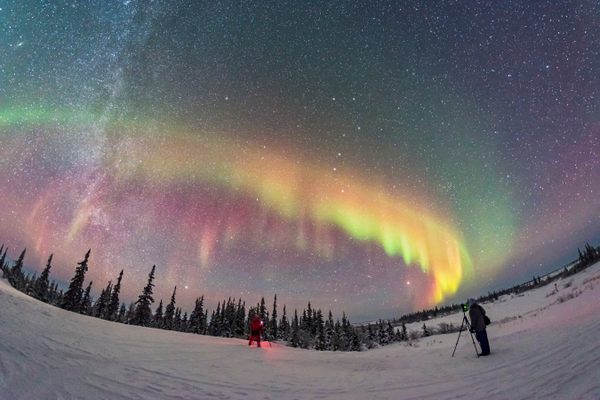A Beginner’s Guide to Finding Your Way in the Heavens
It’s easy to identify planets, stars, and even galaxies once you know where to look for them.
Atlas Obscura’s Wondersky columnist Rebecca Boyle is an award-winning science journalist and author of the upcoming Our Moon: How Earth’s Celestial Companion Transformed the Planet, Guided Evolution, and Made Us Who We Are (January 2024, Random House). Throughout the summer, she’ll be sharing the stories and secrets of our wondrous night sky.
With any luck, you have had a few clear nights this summer to walk out your door and look up. No matter where you are, even in the brightest cities, you can see the Moon shining bright, and some stars and planets. But to experience nighttime as a portal to the universe, and have the chance to see distant galaxies and nebulae, you need to escape artificial light as much as you can. So get in the car, on the train, or on your bike, and head out of town.
The vast majority of humanity now lives in areas where it is impossible to see the Milky Way. And our home galaxy is just one thing no longer visible in our urban skies. Overhead, there are always unspeakably large numbers of stars, inside hundreds of billions of galaxies. To see the nearest of these, you don’t need anything but your own eyes, and a dark night.
First, it helps to find your way around. I have found that navigating the stars is a lot like navigating on Earth: Use landmarks, or celestial waypoints, to figure out where you are and relate other objects to them. You can see where the sun sets, for example, so you can find west and therefore the other cardinal directions north, south, and east. Or maybe you know the interstate is south of your house, and so on. You can do pretty much the same thing in the sky, and use a single starting point to find your way around.
In midsummer, look directly overhead between about 10 p.m. and midnight local time. The brightest star you’ll see is Vega—which you might remember from the Summer Triangle. Once you can find Vega, you can check any star chart, planisphere, or star-finding app to see what’s around it.

For many people, the easiest summertime waypoint is the constellation Ursa Major, or more accurately, the part of it that looks like a giant ladle. Look to the north after sunset for the familiar scoop-and-handle shape of the Big Dipper. Find the outer edge of the scoop. Now imagine tracing a line from those two stars, straight up, toward the brightest star you see next. That star is Polaris. It’s also the tip of the handle of the Little Dipper.
Polaris is our current North Star, because Earth’s northern axis points pretty much toward it. But over a roughly 26,000-year cycle, the direction of Earth’s axis wobbles, and our North Star changes. It has been the star Pherkad (part of the Little Dipper) in the past and, in 12,000 years, our North Star will actually be Vega. (We can blame the Moon for our axial wobble, which I explain in full in my upcoming book.)
Find Vega, find the Big Dipper, and find Polaris—and now you have a good sense of north, south, east, and west in the dome of the heavens. Equipped with this knowledge, you can find anything.
I highly recommend starting your deep-sky stargazing with the most distant thing humans can see with unaided eyes: the Andromeda Galaxy, also known by M31, its number in the Messier Catalog (named for the 18th-century French astronomer Charles Messier).
In mid-July, Andromeda rises very late at night in the northeastern sky. Find Polaris again, and look “under” it, closer to the horizon. You will notice an arrangement of five bright stars that form a letter W standing on its side. That’s the constellation Cassiopeia. And under the bridge of the W, closer yet to the horizon, is a faint little smudge stretching from left to right. If you find it, try looking away from it, slightly to the side; this trick makes it seem even brighter, using your peripheral vision. Andromeda looks great through binoculars, too. If you don’t want to stay up all night to look for it, you can try again starting around mid-September, when the galaxy will be higher in the sky earlier in the night.
This faint wisp on the northern horizon is an entire galaxy that will eventually merge with our own—but not yet. It is about 2.5 million light years away, which means that the light you are seeing in this tiny, cottony smear was emitted before humans evolved. And you just have to look up in order to see it.

If you have access to a telescope, try finding the Pinwheel Galaxy, and witness the spectacular death throes of one of its stars. To find it, start with the Big Dipper. Imagine the first two stars in its handle forming the base of an equilateral triangle that’s “standing” on the handle: The tip of that triangle is the Pinwheel Galaxy, or M101. The supernova that exploded in an outer arm of this galaxy was first documented in May; you can still see the dramatic aftermath.
If you don’t have a telescope but want to see this supernova and other deep-sky objects, chances are you can find a star party somewhere near you at a national park, planetarium, school, or other institution. Just in the next few days, there will be star parties happening from Los Angeles to Lower Michigan and many places in between. These events have a variety of telescopes set up for anyone to use, and are often run by volunteers happy to help you find your place in the stars.
Is there something you’d like to know about our brilliant night sky? Share your stargazing questions with us and you may see them answered in a future Wondersky column!










Follow us on Twitter to get the latest on the world's hidden wonders.
Like us on Facebook to get the latest on the world's hidden wonders.
Follow us on Twitter Like us on Facebook